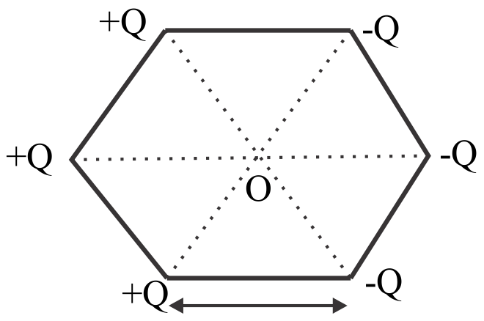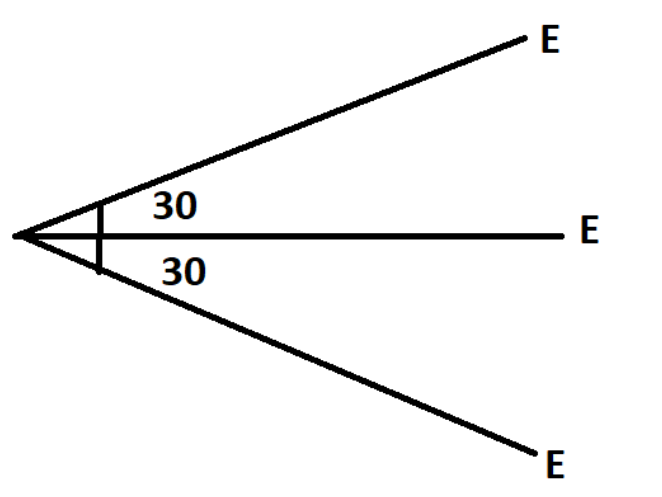
Six charges are placed at the vertices of a rectangular hexagon as shown in the figure. The electric field on the line passing through point $o$ and perpendicular to the plane of the figure as a function of distance $x$ from point o is ($x > > a$):

A. 0
B. $\dfrac{{Qa}}{{\pi {\varepsilon _o}{x^3}}}$
C. $\dfrac{{2Qa}}{{\pi {\varepsilon _o}{x^3}}}$
D. $\dfrac{{\sqrt 3 Qa}}{{\pi {\varepsilon _o}{x^3}}}$
Answer
218.4k+ views
Hint: From the above diagram we can say that this is a question of dipole moment. So firstly we will find the electric field due to the dipole in the axis of dipole and finally we get the resultant of all dipoles.
Electric field at the axis of dipole will be $E = \dfrac{{kp}}{{{x^3}}} = \dfrac{{Qa}}{{2\pi {\varepsilon _o}{x^3}}}$
Complete step by step answer
As from the given figure we have 3 dipole of same unit and inclined as follows:

So now we have to find the resultant of all 3 dipoles
As we all know that other two dipoles are at a ${60^0}$ in reference with third or middle dipole So resultant electric field will be ${E_{resul\tan t}} = 2E$
$\therefore $we have already discussed that the electric field a the axis of the dipole is $E = \dfrac{{kp}}{{{x^3}}} = \dfrac{{Qa}}{{2\pi {\varepsilon _o}{x^3}}}$
So putting the value of E in the resultant equation of electric dipole
$
{E_{resul\tan t}} = 2 \times \dfrac{{Qa}}{{2\pi {\varepsilon _o}{x^3}}} \\
{E_{resul\tan t}} = \dfrac{{Qa}}{{\pi {\varepsilon _o}{x^3}}} \\
$
Therefore, option number C will be the correct answer.
Note: A pair of equal and opposite charges separated by a small distance is called an electric dipole. The dipole moment of an electric dipole is a vector whose magnitude is either charge times the separation between the two opposite charges and the direction is along the dipole axis from the negative to the positive charge.
Electric field at the axis of dipole will be $E = \dfrac{{kp}}{{{x^3}}} = \dfrac{{Qa}}{{2\pi {\varepsilon _o}{x^3}}}$
Complete step by step answer
As from the given figure we have 3 dipole of same unit and inclined as follows:

So now we have to find the resultant of all 3 dipoles
As we all know that other two dipoles are at a ${60^0}$ in reference with third or middle dipole So resultant electric field will be ${E_{resul\tan t}} = 2E$
$\therefore $we have already discussed that the electric field a the axis of the dipole is $E = \dfrac{{kp}}{{{x^3}}} = \dfrac{{Qa}}{{2\pi {\varepsilon _o}{x^3}}}$
So putting the value of E in the resultant equation of electric dipole
$
{E_{resul\tan t}} = 2 \times \dfrac{{Qa}}{{2\pi {\varepsilon _o}{x^3}}} \\
{E_{resul\tan t}} = \dfrac{{Qa}}{{\pi {\varepsilon _o}{x^3}}} \\
$
Therefore, option number C will be the correct answer.
Note: A pair of equal and opposite charges separated by a small distance is called an electric dipole. The dipole moment of an electric dipole is a vector whose magnitude is either charge times the separation between the two opposite charges and the direction is along the dipole axis from the negative to the positive charge.
Recently Updated Pages
A square frame of side 10 cm and a long straight wire class 12 physics JEE_Main

The work done in slowly moving an electron of charge class 12 physics JEE_Main

Two identical charged spheres suspended from a common class 12 physics JEE_Main

According to Bohrs theory the timeaveraged magnetic class 12 physics JEE_Main

ill in the blanks Pure tungsten has A Low resistivity class 12 physics JEE_Main

The value of the resistor RS needed in the DC voltage class 12 physics JEE_Main

Trending doubts
JEE Main 2026: Application Form Open, Exam Dates, Syllabus, Eligibility & Question Papers

Derivation of Equation of Trajectory Explained for Students

Hybridisation in Chemistry – Concept, Types & Applications

Understanding the Angle of Deviation in a Prism

Understanding Collisions: Types and Examples for Students

Understanding Atomic Structure for Beginners

Other Pages
JEE Advanced Marks vs Ranks 2025: Understanding Category-wise Qualifying Marks and Previous Year Cut-offs

How to Convert a Galvanometer into an Ammeter or Voltmeter

Understanding Centrifugal Force in Physics

Ideal and Non-Ideal Solutions Explained for Class 12 Chemistry

Degree of Dissociation: Meaning, Formula, Calculation & Uses

Understanding Electromagnetic Waves and Their Importance




